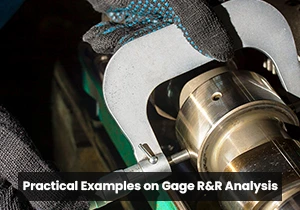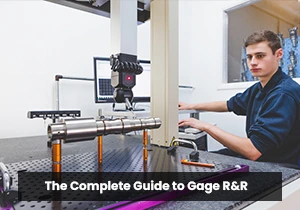Gage r&r Acceptance Criteria: A Dive into Precision and Process Control
Gage Repeatability and Reproducibility (Gage R&R) is a systematic approach designed to quantify the level of variability in measurement results that can be attributed to the measurement system itself.
In a standard Gage R&R (Repeatability and Reproducibility) analysis, the accepted criteria is that the total variation in measurement for a process should not exceed 30% of the given process tolerance. However, for more stringent applications or in cases where the measurement systems are more refined and established, a tighter criterion is often applied. In these scenarios, the measurement variation is expected to be kept below 10% of the process tolerance, reflecting a higher standard of precision and accuracy in the measurement process. Remember, the strength of your quality control services
is greatly enhanced by the robustness of your Gage R&R practices.
Understanding and Applying Gage R&R Acceptance Criteria
In this analysis, three key statistical metrics are employed: % Contribution, % Study Variance, and % Tolerance. Each metric throws light on different aspects of the study, offering insights tailored to its specific objectives.
The % Contribution and % Study Variance statistics reveal the proportion of process variability that can be attributed to distinct sources, in comparison to the overall variation. These insights are crucial in assessing the effectiveness of the measurement system, helping to pinpoint whether the variance predominantly stems from the gage, the operator, or the part itself. Such information is invaluable for refining and enhancing the system's performance.
However, the way these two reports are interpreted and the benchmarks for determining the adequacy of your measurement systems are not identical. Let's delve into the nuances:
% Study Variance Parameters
- Below 10%: This range is generally regarded as satisfactory, indicating a well-tuned measurement system.
- 10-30%: This is a conditional acceptance zone. The suitability here hinges on factors like the method of measurement and the specific application context.
- Above 30%: This indicates an unsatisfactory performance, calling for urgent improvements to the system.
% Contribution Guidelines
- Above 1%: This is considered satisfactory, showing that the system is performing within acceptable limits.
- 1-9%: This is a zone of conditional acceptance, similar to % Study Variance, where the appropriateness is dependent on the measurement method and application specifics.
- Above 9%: This indicates an unsatisfactory performance, calling for urgent improvements to the system.
Acceptance criteria for Gauge R&R studies generated from statistical tolerance intervals as per ISO 16269-6
Based on the information provided, we can derive the following general guidelines:
- When performing a Gauge R&R analysis with 10 samples, achieving a confidence/probability level of 95/99% is possible if the upper limit for acceptance criteria is set at 20%.
- For the same number of samples (n=10) in Gauge R&R, a confidence/probability level of 95/95% aligns with an acceptance criteria maximum of 26%.
- Similarly, with 10 samples in a Gauge R&R study, a confidence/probability level of 95/90% correlates with setting the maximum acceptance criteria at 30%.
The Criteria for Gauge R&R Analysis is also shown in tabular form below:
| Number of Samples (n=10) | Confidence Level | Probability Level | Maximum Acceptance Criteria |
|---|---|---|---|
| 10 | 95% | 99% | 20% |
| 10 | 95% | 95% | 26% |
| 10 | 95% | 90% | 30% |
Table: Acceptance Criteria for Gauge R&R Analysis Based on Sample Size, Confidence, and Probability Levels In essence, these metrics don't just measure; they guide. They provide a sketch for understanding and enhancing the measurement system, ensuring that it not only meets but adapts to the evolving demands of accuracy and precision.
Establishing clear Gage R&R acceptance criteria is vital for the integrity of any measurement system within quality control services. By adhering to these standards, organizations can ensure accurate, reliable, and consistent data, which is fundamental to maintaining high-quality outputs.


